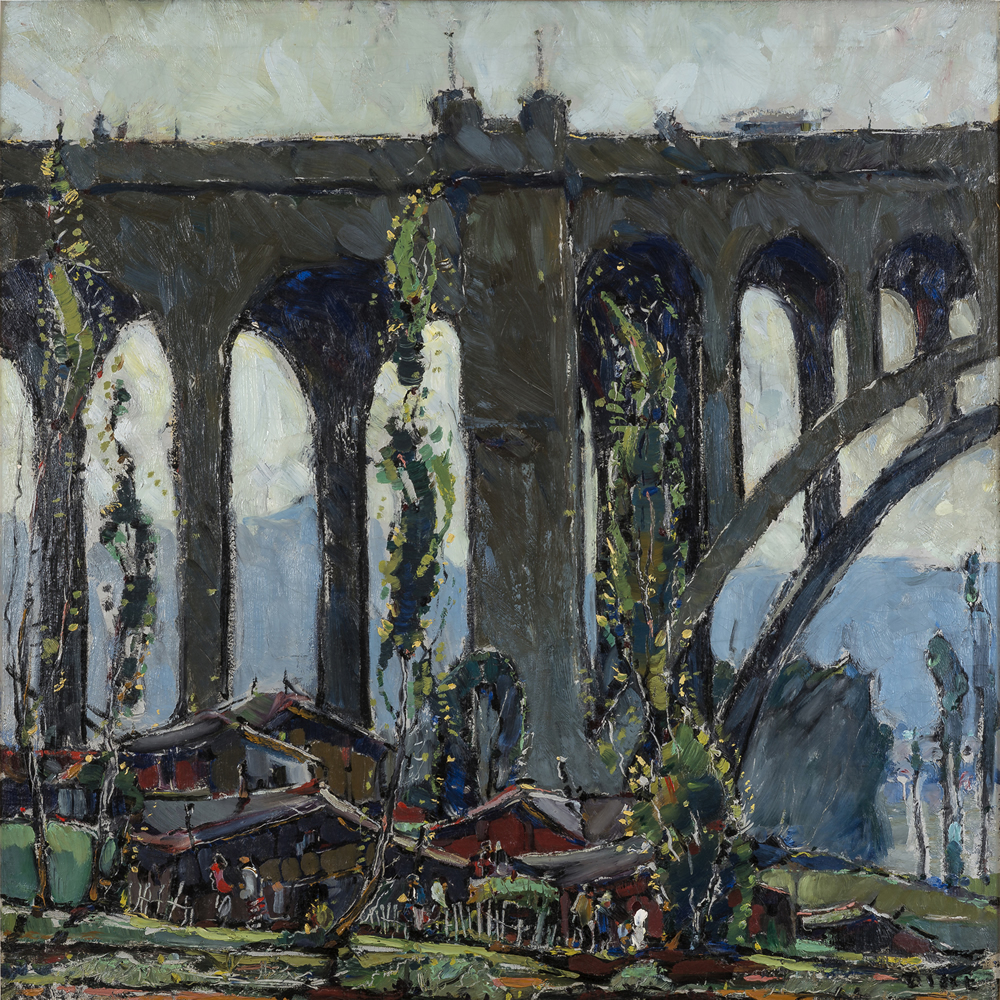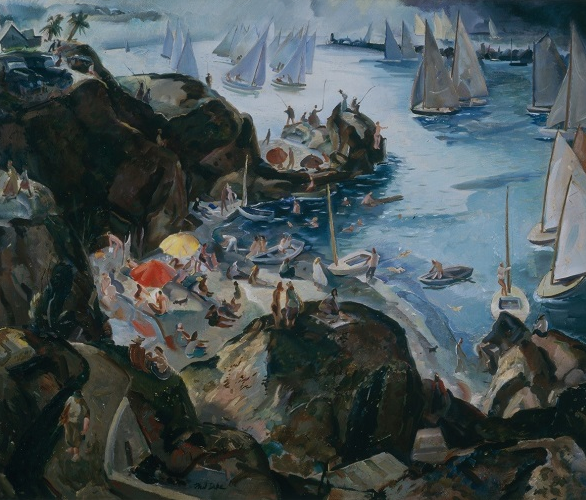“

An artist is the interpreter of his own thoughts and conclusions. Each painting is a new beginning, a new day to define his, the artist’s, feelings, thoughts and conclusions….” Phil Dike (1906-1990) wrote those words in 1976, a key decade of his long career which was by all evidence one of constant learning, processing and continuous stylistic evolution.
“Phil Dike: At the Edge of the Sea,” currently on view through Sept. 24 at the Laguna Art Museum, is the long anticipated retrospective exhibition of Dike’s prolific oeuvre curated by Janet Blake, curator of historical art at the Laguna Art Museum.
Two years ago, Blake organized a preview exhibition of roughly a dozen canvasses from the Wave and Malibu Set series (1968-1981) that gave viewers an impression of his later work, semi-abstracted or abstracted and mostly of the sea. At that time the Laguna College of Art and Design also featured a show of Dike’s paintings, sketchbooks and memorabilia titled “Of Light and Shadow and Beyond.”
While it hinted at the artist’s versatility, vision and a willingness to approach his subject matter freshly at every try, it did not forecast the wealth of directions and styles, techniques and insights of an artist who was also a poet, philosopher and impassioned teacher.
With “….At the Edge of the Sea,” Blake has now delivered a stunning show that could easily be divided into three. While one might expect a few fillers in an exhibition of this size, this show consistently evidences Dike’s unique gift.
Let’s begin with the 1938 painting “California Holiday,” used as Life magazine cover. Here Dike looks down the cliffs to a frolicking beach crowd at Corona del Mar. It’s a vantage point he uses often in his compositions, whether depicting a bustling New York stock market scene, copper mines or views of Elysian Park. He casts himself into the role of observer and documentarian. Dike visited the Newport Beach area with his family as a youngster. In 1943 he moved his family into Corona Del Mar where he lived for years and in 1947 founded the Brandt-Dike Summer School of Painting with his friend Rex Brandt From then until 1955, Brandt estimates that some 4000 students attended the school’s six week summer sessions.
This painting, along with other early work such as the 1928 “LA County Fair, Pomona,” reveals Dike’s liking of people, of crowds and his talent to convey idiosyncrasies of spirit and locale. “Pasadena Bridge,” of the same year, is a personal favorite along those lines.

Dike attended the the Chouinard Art Institute where he studied under Clarence Hinkle and met Millard Sheets, with whom he joined the California Watercolor Society. He also studied in New York under George Luks, a short-lived influence since he found his work too dark, and Vincent DuMond, who taught him to look for an imaginary, glowing rainbow over each landscape. Paintings such as the 1947 representational “Balboa” and much later, the 1972 abstract “Wave Echo #3” suggest that the lesson took hold.
Dike also ventured farther inland to Arizona where he courted his wife to be, Betty Love Woodward. There he became inspired by the vastly different landscapes of towns like Jerome, Globe and Miami, their craggy hillsides and open-pit mines to produce “Inspiration Copper,” 1932 and “Copper,” 1936. Both show a veering away from his earlier, more impressionistic style in favor of flatter geometric shapes and concentrated light.
Also painted in Jerome, “Then it Rained,” 1939. The watercolor is a show-stopper with its depiction of a sudden rain storm. Clouds swirl and buildings look oddly skewed as if about to be blown over. Colors emphasize the darkly dramatic mood.
It’s noteworthy that Dike had worked for Disney, officially since 1935, with his most important role as color coordinator and consultant. While he was there, the animated classics “Bambi,” “Dumbo,” “Pinocchio” and “Snow White” came to life. But, it’s the epic “Fantasia” with its “Night on Bald Mountain” that may have stylistically informed the rain painting.
Scene Painting is not shortchanged here either as evidenced by “Wash Day,” 1935, and “Grape Harvest,” 1941, among others. But, to the immediately contemporary eye, things get even more interesting when abstract elements become increasingly prevalent as in “Harbor Tapestry,” 1950, and “Golden Rocks,” 1950.
By the late 1960s, early ‘70s, Dike begins to abstract beach scenes, waves and people into increasingly flat and linear forms. “Window on the Sea” and “Window on the Sea #3” 1972, set apart by their sunny palette, “Moon Flight,” 1972, by flocks of birds condensed into triangular shapes and “Big Sur Set #4,” an abstraction of a crashing blue wave outlined in white, are elegant distillations of beach scenes.
Later he began to conceptualize life near the sea as exemplified by “Beach People and Shells,” 1979, “Shore Birds,” 1980, “Tide Circles,” 1980 and “Shell Structure and Sea Garden,” 1980.
And, let’s not forget that Dike was also a prolific print maker. One of the most intriguing prints is “Untitled. Spear Fishers,” due to its strong linear depiction of figures.
In 1976 Dike also wrote: “To the artist line is the basic and personal form of expression. It follows the sensitized thoughts opportunistic in its devious movement. Guided in the labyrinth by a hand not new to the possibilities of the performance….”





[…] Read the article online here. […]